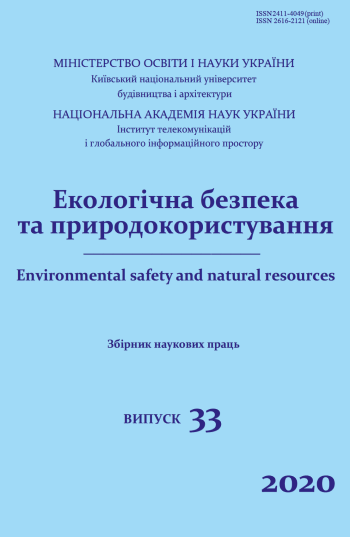Аssessment of the risk of emergency situations during the storage of galvanic waste
DOI:
https://doi.org/10.32347/2411-4049.2020.1.75-86Keywords:
hazard index, plate production, waste recycling, environmental safetyAbstract
The article is dedicated to the research of the consequences of emergencies related to the storage of waste (sludge) on the territory of the enterprise, as well as directly in the process of carrying out technological processes for the estimation of danger to health and human life. The problem of industrial and household waste recycling is becoming more pressing problem nowadays taking into consideration constantly increasing volume of waste generation, while the rate of its processing is incomparably small. As a result, hundreds of millions of tons of various solid wastes must be recycled and disposed. The scale of annual production and accumulation of solid waste requires the creation of powerful processing plants with a capacity of millions tons per year with their industrial development. The environment is considered to be safe when its condition meets legislated criteria, standards, limits and standards established by legislation concerning cleanliness (not pollution), not exhaustion, environmental sustainability, sanitary requirements, ability to satisfy the interests of citizens. The level of environmental pollution in the areas of production of plates, galvanizing and painting plants, which are the greatest sources of environmental hazard and belong to main pollutants. The question of risk estimation and management in different production branches of Ukraine and leading countries nowadays became urgent and significant because of repeated use of chemical elements, imperfection of disinfection and utilization processes. The work objective lies in estimation of hazard level to human health and life consequent on occurring emergencies, connected with galvanizing processes and waste conservation (sludge) on the territory of the enterprise. Sludge hazard classes during production of plates and galvanics are defined, allowing a possibility of searching the ways for increasing ecological safety level of territories of enterprises, involved in plate and galvanics production. Application of “risk” definition lead to impossibility of the development of unified approach to its estimation. Plenty of risk types exists, among which is ecological risk. National standard of Ukraine (ДСТУ 2156-93. Industrial safety. Definitions) specifies rick of industrial enterprises as probability of potential danger realization, initiated by industrial enterprises and (or) negative consequences of this realization. On the grounds of research results of galvanic sludge content the effective content and dangerous substances content was determines. Two examples of sludge taken from different Ukrainian enterprises, kept inside plantsite area, were shown. It was determined that hazard index is above normal and this risk level is inadmissible. Emergencies, accompanied by storage area dismemberment and lead to galvanic sludge insertion into the environment, increasing risk for human health. Obtained level of carcinogenic risk and hazard index indicate on the necessity of carrying complex of resolutions concerning prevention of emergencies and minimizing their consequences. Following researches have to be directed for search of alternatives of sludge storing on the territories of enterprises, for wastes utilization with separation of valued components and recurrent use of solutions in technological processes.References
Bharti, N., & Katyal, D. (2011). Water quality indices used for surface water vulnerability assessment. Inter. J Environ. Sciences, 2(1), 154-173.
Pohrebennyk, V., Koszelnik, P., Mitryasova, O., Dzhumelia, E., & Zdeb, M. (2019). Environmental monitoring of soils of post-industrial mining areas. Journal of Ecological Engineering, 20(9), 53-61.
Pohrebennyk, V., Mitryasova, O., Dzhumelia, E., & Kochanek, A. (2017). Evaluation of surface water quality in mining and chemical industry. In Proceedings of the 17th International Multidisciplinary Scientific GeoConference SGEM, Albena, Bulgaria, 2017. (vol. 17, issue 51, pp. 425-433).
Ishchenko, V., Pohrebennyk, V., Borowik, B., Falat, P., & Shaikhanova, A. (2018). Toxic substances in hazardous household waste. In Proceedings of the International Multidisciplinary Scientific GeoConference Surveying Geology and Mining Ecology Management, SGEM. (18 (4.2), pp. 223-230).
Petryk, A., Czop, M., & Pohrebennyk, V. (2018). The assessment of the degree of pollution of fallow vegetation with heavy metals in rural administrative units of Psary and Płoki in Poland. In Proceedings of the International Multidisciplinary Scientific GeoConference Surveying Geology and Mining Ecology Management, SGEM. (18 (5.2), pp. 921-928).
Mitryasova, О., Pohrebennyk, V., & Kardasz, P. (2018). Hydrochemical Aspects of Surface Water Quality Assessment. In Ecology and Environmental Protection. Ecology, Economics, Education and Legislation: 18th International Multidisciplinary Scientific Geoconference SGEM. Proceedings of the Conference, Albena, Bulgaria, 30 June – 9 July 2018. (5.2., 18, pp. 513−520).
Mitryasova, O., Pohrebennyk, V., & Selivanova, A. (2018). Environmental Risk of Surface Water Resources Degradation. Water Supply and Wastewater Removal, pp. 152-162.
National report on the state of the environment in Ukraine. http://old.menr.gov.ua/index.php/dopovidi. (in Ukrainian)
Nester, A.A. (2016). Cleaning of water of virobnittva druckovanich boards: monograph. Khmelnitsky: Khmelnitsky National University. (in Ukrainian)
DSanPin 2.2.7.029-99. Hygienic requirements for the management of industrial waste and the definition of a hazard class for public health. 01.07.1999 N 29. (in Ukrainian)
Rukovodstvo Р2.1.10.1920-04. Rukovodstvo po otsenke riska dlya zdorovya naseleniya pri vozdeystvii khimicheskikh veschestv, zagryaznyayuschikh okruzhayuschuyu sredu. M.: Federalnyy tsentr gossanepidnadzora Minzdrava Rossii, 2004, 144 p. (in Russian)
Karaeva, N.V., & Varava, I.A. (2018). Metody i zasoby otsinky ryzyku zdorovyu naselennya vid zabrudnennya atmosfernogo povitrya. Kyiv: KPI im. Igorya Sikorskogo. (in Ukrainian)
Downloads
Published
How to Cite
Issue
Section
License
Copyright (c) 2020 Volodymyr D. Pohrebennyk, Anatoly A. Nester

This work is licensed under a Creative Commons Attribution 4.0 International License.
The journal «Environmental safety and natural resources» works under Creative Commons Attribution 4.0 International (CC BY 4.0).
The licensing policy is compatible with the overwhelming majority of open access and archiving policies.

